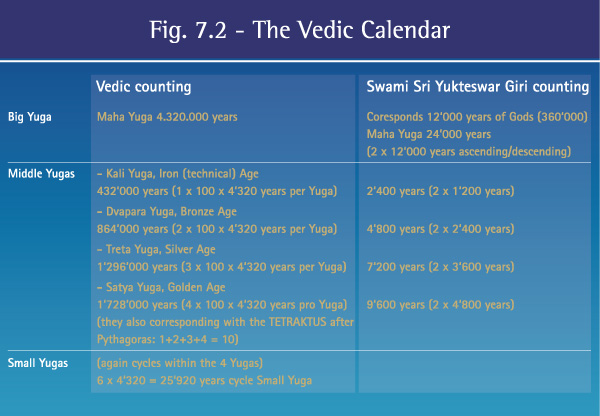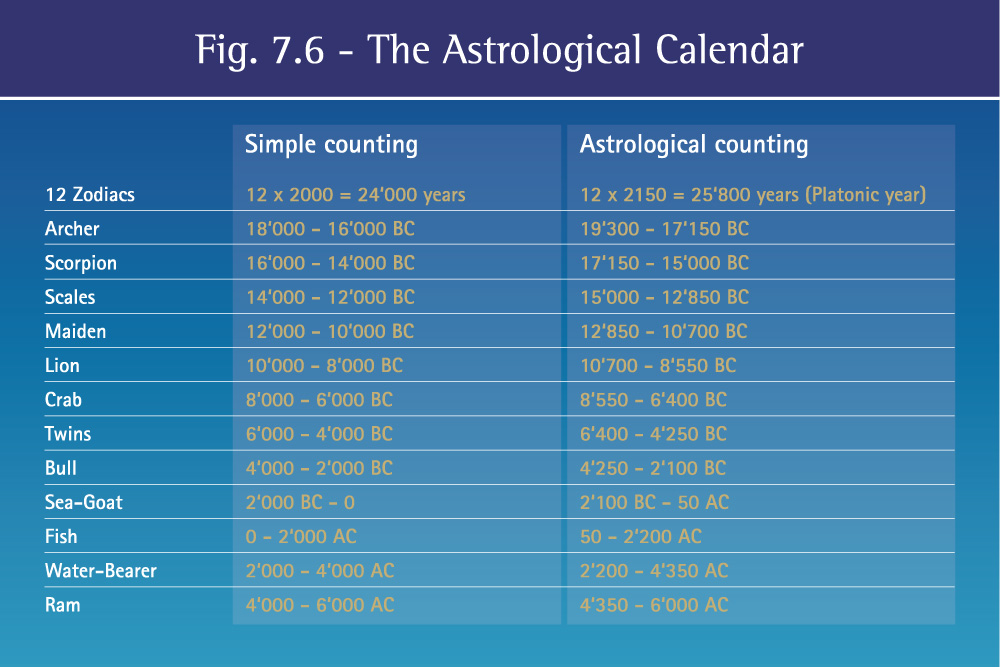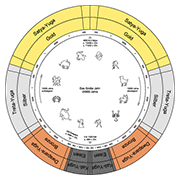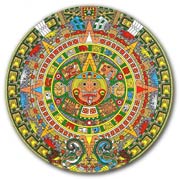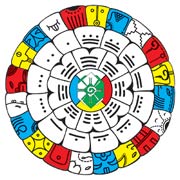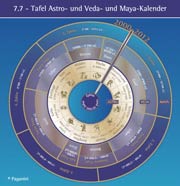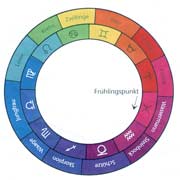Calendars with ages
Let us examine the three most notable calendar cycles,
which encompass this view:
- Yugas from the Indian Vedic calendar
- Ages of the Mayan calendar
- Ages of the astrological calendar
Astoundingly, all three of these calendars have complete cycles of
between 25,600 and 25,900 years and they share a surprising point
that occurs sometime between the years 1900 and 2200 AD by our
calendar. The Tibetans, the ancient Egyptians, and the Cherokee and
Hopi Indians all also chart a cycle of 26,000 years.
The Vedic Calendar
In the Vedas, the ages are called yugas and the great world age of
4,320,000 years is called the Maha Yuga. 1,000 such Maha Yugas equals
one Kalpa, the day of Brahma. For him this lasts 12 hours, or as it is
metaphorically expressed in the Vedas, the time it takes Brahma,
the central intelligence of our visible universe (of which there are
supposedly four more), to inhale and exhale once. Therefore, it takes
him 13,000 years to inhale and one-half orbit of the Sun to exhale.
Maha Yugas contain 4 middle yugas between 432,000 1,728,000 years and,
in turn, even shorter yugas of 4,320, i.e. one-tenth of the whole.
The individual periods of a world age are the Satya Yuga (some called
Krita), the Treta Yuga, the Dvapara Yuga (sometimes called Vapara) and
the Kali Yuga.
These time periods are different – in addition to different
durations – especially qualitatively. In gold Satya, paradisiacal
conditions reign supreme and the law of life (dharma) is fully
comprehended and practiced. The fulfillment of dharma, however,
shrinks by one-fourth from world age to world age. Therefore,
only threefourths dharma remains in silver Treta and only half in
bronze Dvapara. In iron Kali Yuga, spiritual, moral, ethical and
social conditions reach a lowest point with one-fourth, which is
the weakest and worst state.
According to the Vedic tradition, the ages devolve in increments,
from the ages described as gold, silver, and copper to an “iron” or
“technical” yuga, which is where we find ourselves today.
The outer material world, as well as the spiritual state of being,
is heavily influenced by the three root poisons of hatred, greed
and bedevilment.
Kali Yuga literally translated means the Goddess Kali, and because
of this she is usually called “the Black One”. Every noun has an
adjective in Sanskrit, and so this yuga is called the Black Age.
It is equated with the Greek “Iron Age” described by Hesiod in the
“Theogony”. This “dark age” is, therefore, affected to a great extent
by war and suffering and is also appropriately deemed the “Age of Decline”.
However, according to Vedic tradition, a new Buddha appears at the end
of a dark age, who brings liberating and enlightening teachings that
lead into a new era of truth (Satya Yuga).
According to legend, 1,000 Buddhas will appear in this aeon (kalpa in
Sanskrit), who will set, once again, the “Wheel of Dharma and
Enlightenment” into motion. According to Buddhist tradition,
Buddha Shakyamuni was (563 BC) the 4th of these Buddhas to
have appeared in this age and the appearance of the 5th Buddha
(Maitreya) is predicted for this century. Once this occurs, the cycle
time of this aeon will be complete and the world as we know it will be
disbanded. For Hindus, history is an endless cycle of successive and
repetitive world ages of enlightenment.
According to an acclaimed interpretation of the duration of the world age
by Swami Sri Yukteswar Giri in his book “The Holy Science”, the actual
duration of a complete cycle of the four yuga is only 24,000 years, with
ascending and descending cycles of 12,000 years each. The extreme
lengths of these periods were based on an adopted calculation error that
resulted in the Kali Yuga from the multiplication of spiritual levels.
According to Sri Yukteswar, one satya with 400 years of transitional
period is 4,800 years, one treta with one transitional period of 300 years
each is 3,600 years, one dvapara with transitional periods of 200 years
is 2,400 years and one kali with transitional periods of 100 years is
1,200 years.
Conclusion about dating
According to interpretation of the available sources, the current Kali
Yuga began around 800 AD and ended around 2000 AD, according to
Sri Yukteswar Giri. (This does not mean that we assume the astrologically
beginning of February 18, 3102 BC listed in Thompson’s “Vedic
Cosmography”, page 19, after the death of Krishna on February 17, 3102,
two more of the few connections to the astrological calendar).
The Mayan Calendar
The Mayan calendar – or more precisely, calendars – is the sophisticated
calendar system of the Mesoamerican indigenous peoples. They used a
combination of three different calendars for astronomical, ritual and
civil purposes to make a whole. These calendars are based on the 20-day
counting system of the ritual Tzolkin calendar, the civil Haab calendar
and the Long Count calendar (with which long periods could be recorded,
an important aspect of their cosmic observations and astronomy).
The combinations of the dates of the Tzolkin and Haab calendars repeat
themselves in a 52-year calendar cycle. There were others with different
periods in addition to these three main calendars, but all were combined
into one overarching calendar. The complexity and accuracy of this
calendar system is truly even more impressive than the Vedic
and the astrological calendars.
The reincarnation beliefs of the Maya states that the fine-matter body
exists in cycles of world years (25,920 years), world months
(2,160 years) and world days (144,000 days = 1 baktun).
We also encounter the number 144 in the Vedic Maha Yuga
(6 x 24,000 = 144,000 days) and as a holy figure in the
Revelation of John.
Long Count Calendar
The Maya needed their Long Count calendar for astronomical calculations.
The individual positions run from 0 to 19, up to the first to last position,
which ends at 17. The Long Count calendar allows for a dating system
that clearly establishes every day over a period of 5,200 years.
But this is a minor cycle, because five of these cycles result in the
longer 26,000-year cycle (a major cycle ends and another begins on
December 21, 2012, or their 13.0.0.0.0. The number 13 was one of the
important numbers for the Mayans, which is why the period
from 0.0.0.0.0. to 13.0.0.0.0. is described as an era.
This change is comparable to our transition from
December 31, 1999 to January 1, 2000).
Short Count Calendar
The Short Count calendar is consistent at 13 months x 28 days + one
correction day = 365 days with our solar year.
The Haab
The Haab Count served earthly purposes for the Maya, such as the
calculation of sowing and harvesting times and corresponds to our
calendar since it comprises a solar year of 365 days. The Haab
calendar year is divided into 18 months with 20 days and one month
with only five days.
The Tzolkin
The Maya used the Tzolkin (Count of Days) for ritual purposes,
since every day (kin) was named after one of 20 guardian deities
(or day names) using a combination of numbers (Ton / month)
from 1 to 13. The Tzolkin date designates, therefore, a date within
a period of 260 days. Each of the 13 tones and 20 seals are assigned
certain attributes and so each day of the Tzolkin represents a unique
quality, similar to astrology.
The Calendar Cycles
Because the Haab and Tzolkin calendars comprise 365 days and 260
days respectively, they repeat every 18,980 days (lowest common
denominator of 365 and 260) or 52 Haab years, key dates of the
Haab and Tzolkin counting systems. Therefore, this period is called
a calendar round, in which the combination of Haab and Tzolkin
dates is clear.
Conclusion about dating
Upon interpreting the available sources, the 5th cycle of the Long
Count calendar ends on December 22, 2012, which coincides
exactly with the beginning of the winter astrological calendar.
The astrological calendar
Approximately every 25,800 years, our solar system completes one
orbit around the central sun in the Pleiadian star constellation and in
doing so passes through the twelve constellations, each constellation
constituting 2,150 years.
The astrological age changes because the Earth, in addition to its own
rotation around the sun, experiences a third movement around its axis,
the precession. Therefore, the constellations used to classify astrological
ages (zodiac) are not to be confused with the signs of the zodiac.
The zodiac begins on the vernal equinox (the zodiac sign of Aries) and
cycles through, so that the zodiac signs of today no longer correspond
to the constellations. This discussion will always refer to the constellations.
In our time, the vernal equinox is located between the constellations of
Pisces and Aquarius. Astrologers diplomatically speak of a “transition period”
into the Age of Aquarius, which began in the 1960s and will last a few
decades into the new millennium. The exact date of the transition is hotly
contested, as you will read below. Because the occurrence of the vernal
equinox has still not been able to be defined and established, and if you
take the current constellation boundaries as a basis, the transition would
first take place in the year 2600 AD. We will now explore the age of the
astrological calendar and its aspects, from the constellation Taurus
(from 4000 BC) through the constellations Aries and Pisces to the new
constellation of Aquarius (from 2000 AD).
Firstly, we set timespans of roughly 2000 years per constellation,
because in our line of thinking increments of 2000 years are quite
convenient since they coincide precisely with the millennium changes.
Starting from the Age of Aquarius, we will now take a look at the more
accurate dating systems as well as the controversies surrounding it.
The Age of Taurus (4000-2000 BC)
Architecture and farming methods develop in this age. This period
saw the construction of almost all of the Seven Wonders of the World
and architecture dedicated to the bull culminated in this period.
A striking example is Ancient Egypt, which managed to develop a highly
advanced civilization along the Nile River with unexplained architecture
and novel agricultural and irrigation practices. Cults dedicated to Taurus
were common in many regions, but were most active in Memphis (Api)
and Crete (Minotaurus). There were also sporadic occurrences in South
America, especially in Peru.
The Age of Aries (2000 BC-0)
This age brings forth great empires and their various power structures
and jurisdictions. At the beginning of the 6th Century BC, the powerful
princes of Persia created a vast empire, the size of which has not been
achieved by any other state on Earth. In the battle of Issus (about 330 BC),
the Persian army was defeated by Alexander the Great and their multi-ethnic
state disbanded by the Greek government. The last great empire was
achieved by the Romans, who shaped the language, culture and
jurisprudence of present time. An interesting event that occurred just in time
for the paradigm shift after the Age of Aries was the assassination of Julius
Caesar in 47 BC, which ushered in the disintegration of the Roman Empire.
The Age of Pisces (0-2000 AD)
Approximately 2,150 years ago the vernal equinox occurred in the
constellation of Pisces. Jesus Christ, the herald of the New Testament
of Love, appeared on the earth. The Age of Pisces was shaped by
Christianity (the fish with two lines also became its secret symbol),
which established a new world view focused on love of God and love
of neighbor, the spiritual and life after death. With belief in a spiritual
world in the afterlife, man took upon himself the hard burden of material
incarnation in this world.
Although the Age of Aquarius is actually attributed to the expansion of
organized religion, important basic teachings and new lines of thinking
(Buddhism, Christianity and Islam) emerged in the Age of Pisces.
They have resulted in the modern world religions and their institutional
places of worship. Millions of people have been killed by churches,
nations and armies in the name of religion and God – in the second
millennium of the Age of Pisces above all – which is quite contrary to
the tolerance that is supposed to characterize the Age of Pisces, even
amidst aggressive manipulation from the dark hierarchy.
The Age of Aquarius (2000-4000 A.D.)
The vernal equinox then occurred, which was caused by the precession
of the Earth into the constellation of Aquarius. Thus the world has been
in the beginning of the Age of Aquarius (also known as the Aquarian Age
or Modern Age) since the dawn of the 21st Century. From the perspective
of the astrological calendar, we are now at the end of an old and at the
beginning of a new era. The Age of Aquarius promises to be a period of
individualism. Self-development through belief in the creator god, oneness,
love and qualities like personal freedom, free will, tolerance, openness and
forgiveness should be definitive. The spirit of the Age of Aquarius will even
have an effect on research, science, economics and politics. A new
Zeitgeist (spirit of the times) will captivate humanity and allow for another
major step in evolution. But we now have to be more accurate here,
because an increment of 2,000 years for every constellation is incorrect.
Scientifically speaking, the duration is more like 2150 years.
Equally false is that the changing of the constellations corresponds exactly
with the transition of our present millennium as calculated by the Christian
calendar using the Gregorian model, although another interesting correlation
occurs here. Accordingly, the Age of Aquarius began in the late 18th Century
of our calendar.
The result of this more accurate calculation coincides with two historically
significant events characterized by the “new consciousness”,
which is backed by a few sources.
- The American Declaration of Independence of 1776 states:
“It is not their right to be free, it is their duty!”
- And the French Revolution (1789 – 1799), with its far-reaching impact on all cultures of the modern era, influenced us with the promise: “Liberty, Equality and Fraternity”, for these are also regarded as definitive characteristics of the Age of Aquarius.
Astrologers have marked the beginning of the Age of Aquarius as 1892.
According to Edgar Cayce it occurred in 1932, while Dr. Hartmut Normann
determined the date of the transition to have been on March 5, 1962
when all seven planets were located in the constellation of Aquarius.
Conclusion about dating
Upon interpreting the available sources, the Age of Pisces began before
the birth of Christ and therefore, the beginning of the Age of Aquarius
occurs between 2000 and 2200 AD.
The Egyptian-Atlantean calendar
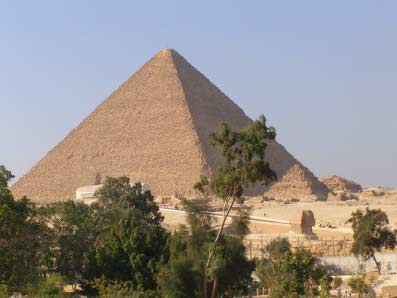
There is also a fourth but little known “Egyptian” or “Atlantean”
calendar of cycles, which is encoded in the Great Pyramid of Giza.
One of their cosmic masses is the sum of the crossed diagonals with
25,826.6 pyramid inches, or about 26,000 in their relation to the galactic
light pyramid. This pyramidal calendar of cycle ends with the year 2001
of our calendar. It is also interesting to note that Atlantis fell around
11,000 BC, or about 13,000 years ago, at the precise turning point of the
25,920-year elliptical orbit of our solar system. This “calendar” is
probably best documented in Charles Berlitz’s book “Doomsday 1999”.
Yet all of these cyclical calendars remain a tradition of the respective
civilizations and their spiritual variables that caused them to attempt to
classify and record their worldview and history.
On the one hand they are very different, if one compares, for example,
the cyclical and thematic divisions of the Christian, Vedic and Indian
calendars. On the other hand, they all have two outstanding factors
in common: They end after a single total revolution of around 26,000
years as well as around the same turning point or new beginning.
According to these rules of interpretation, one could come to the
understanding that the contents of these three calendars complement
each other, which is already the case for the world religions:
The Vedic calendar and its yugas comprise a fairly detailed framework
with many additional and even larger cycles (as corresponds to spiritual
vision); the astrological calendar and its constellations explain the stellar
oscillations and influencing characteristics (which act in the sub-levels and
sub-cycles) and; the Mayan calendar allows implementation in the everyday
lives of people (for all areas of life). Thus the cyclical calendars also
served to determine the timing of the turning points of their calendars,
which allowed these civilizations to consciously classify themselves in
their own development and implementation. But I want to say that, with
this calendar, it is not possible to determine such big changes with a single
or general date because such transitions proceed gradually and not abruptly.
Only once the Creator grants the blessing, and the moment in time and
quality as determined by the Creator has been fulfilled, will the actual
transition occur…
This is an excerpt from the book DEI LEGACY.

